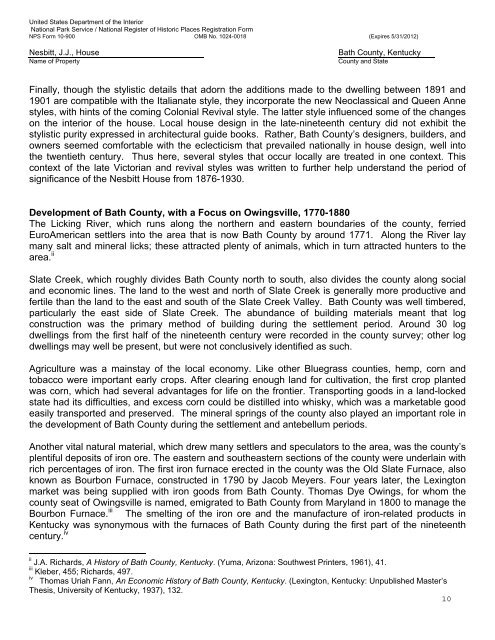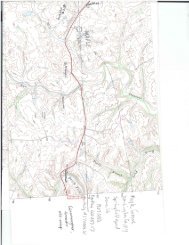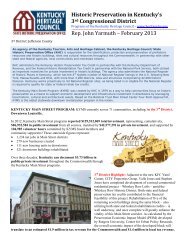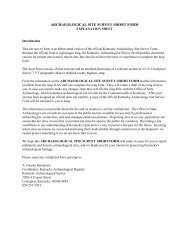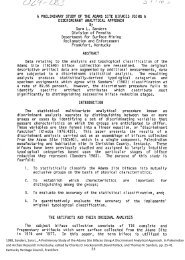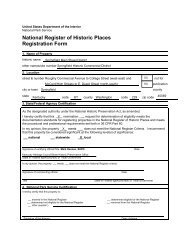JJ Nesbitt House - Kentucky: Heritage Council
JJ Nesbitt House - Kentucky: Heritage Council
JJ Nesbitt House - Kentucky: Heritage Council
You also want an ePaper? Increase the reach of your titles
YUMPU automatically turns print PDFs into web optimized ePapers that Google loves.
United States Department of the Interior<br />
National Park Service / National Register of Historic Places Registration Form<br />
NPS Form 10-900 OMB No. 1024-0018 (Expires 5/31/2012)<br />
<strong>Nesbitt</strong>, J.J., <strong>House</strong><br />
Name of Property<br />
Bath County, <strong>Kentucky</strong><br />
County and State<br />
Finally, though the stylistic details that adorn the additions made to the dwelling between 1891 and<br />
1901 are compatible with the Italianate style, they incorporate the new Neoclassical and Queen Anne<br />
styles, with hints of the coming Colonial Revival style. The latter style influenced some of the changes<br />
on the interior of the house. Local house design in the late-nineteenth century did not exhibit the<br />
stylistic purity expressed in architectural guide books. Rather, Bath County’s designers, builders, and<br />
owners seemed comfortable with the eclecticism that prevailed nationally in house design, well into<br />
the twentieth century. Thus here, several styles that occur locally are treated in one context. This<br />
context of the late Victorian and revival styles was written to further help understand the period of<br />
significance of the <strong>Nesbitt</strong> <strong>House</strong> from 1876-1930.<br />
Development of Bath County, with a Focus on Owingsville, 1770-1880<br />
The Licking River, which runs along the northern and eastern boundaries of the county, ferried<br />
EuroAmerican settlers into the area that is now Bath County by around 1771. Along the River lay<br />
many salt and mineral licks; these attracted plenty of animals, which in turn attracted hunters to the<br />
area. ii<br />
Slate Creek, which roughly divides Bath County north to south, also divides the county along social<br />
and economic lines. The land to the west and north of Slate Creek is generally more productive and<br />
fertile than the land to the east and south of the Slate Creek Valley. Bath County was well timbered,<br />
particularly the east side of Slate Creek. The abundance of building materials meant that log<br />
construction was the primary method of building during the settlement period. Around 30 log<br />
dwellings from the first half of the nineteenth century were recorded in the county survey; other log<br />
dwellings may well be present, but were not conclusively identified as such.<br />
Agriculture was a mainstay of the local economy. Like other Bluegrass counties, hemp, corn and<br />
tobacco were important early crops. After clearing enough land for cultivation, the first crop planted<br />
was corn, which had several advantages for life on the frontier. Transporting goods in a land-locked<br />
state had its difficulties, and excess corn could be distilled into whisky, which was a marketable good<br />
easily transported and preserved. The mineral springs of the county also played an important role in<br />
the development of Bath County during the settlement and antebellum periods.<br />
Another vital natural material, which drew many settlers and speculators to the area, was the county’s<br />
plentiful deposits of iron ore. The eastern and southeastern sections of the county were underlain with<br />
rich percentages of iron. The first iron furnace erected in the county was the Old Slate Furnace, also<br />
known as Bourbon Furnace, constructed in 1790 by Jacob Meyers. Four years later, the Lexington<br />
market was being supplied with iron goods from Bath County. Thomas Dye Owings, for whom the<br />
county seat of Owingsville is named, emigrated to Bath County from Maryland in 1800 to manage the<br />
Bourbon Furnace. iii The smelting of the iron ore and the manufacture of iron-related products in<br />
<strong>Kentucky</strong> was synonymous with the furnaces of Bath County during the first part of the nineteenth<br />
century. iv<br />
ii J.A. Richards, A History of Bath County, <strong>Kentucky</strong>. (Yuma, Arizona: Southwest Printers, 1961), 41.<br />
iii Kleber, 455; Richards, 497.<br />
iv<br />
Thomas Uriah Fann, An Economic History of Bath County, <strong>Kentucky</strong>. (Lexington, <strong>Kentucky</strong>: Unpublished Master’s<br />
Thesis, University of <strong>Kentucky</strong>, 1937), 132.<br />
10


